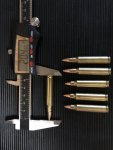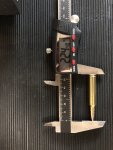So I have been reloading for bolt action for a couple years with decent success. Earlier this year I decided to start reloading for match quality .223 ammo for my SPR. To say its been frustrating would be a huge understatement. I am about to say to hell with it and just buy Prime or Black Hills ammo for it. Its one thing after another. Today I drive an hour to the range in hopes of a decent session with some ammo I loaded. Just about every other round would not chamber. I bought the 1x fired cases from a respected brass reseller in the PX here. It was advertised as "fully processed". Aside from the necks not be deburred or chamfered, I assumed this meant it was ready to load, which is what I did.
25.5gr 8208XBR
52gr Berger FB Target
2.2455" COAL
Please help me figure out what I need to do here. I am guessing the brass is the problem. I dont know how, or even if, it was resized. I assummed "fully processed" would include resizing and since 99.9% of .223 ammo is fired thru a gas gun, that the resizing would have been done using small base dies. Maybe I am wrong. This gun is a Noveske with WOA 1:7 SPR barrel. Its been a very good shooter with factory ammo and has not been picky as far as a "tight chamber" or anything else as far as I am concerned with any factory ammo. As you can see some bullets got jammed back into the case, others didnt and just jammed keeping the bolt from going into battery. Wha I dont understand is the cartridges arent loaded "long", they were below the 2.25" max COAL and fed from a USGI 20 rnd mag so why are they getting jammed and why is the bullet getting jammed back into the case?
Please advise. Thanks
25.5gr 8208XBR
52gr Berger FB Target
2.2455" COAL
Please help me figure out what I need to do here. I am guessing the brass is the problem. I dont know how, or even if, it was resized. I assummed "fully processed" would include resizing and since 99.9% of .223 ammo is fired thru a gas gun, that the resizing would have been done using small base dies. Maybe I am wrong. This gun is a Noveske with WOA 1:7 SPR barrel. Its been a very good shooter with factory ammo and has not been picky as far as a "tight chamber" or anything else as far as I am concerned with any factory ammo. As you can see some bullets got jammed back into the case, others didnt and just jammed keeping the bolt from going into battery. Wha I dont understand is the cartridges arent loaded "long", they were below the 2.25" max COAL and fed from a USGI 20 rnd mag so why are they getting jammed and why is the bullet getting jammed back into the case?
Please advise. Thanks
Last edited:


